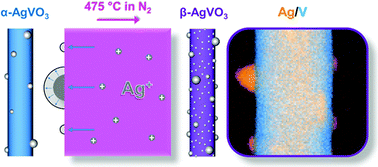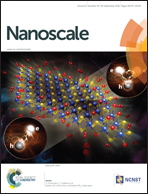The structural conversion from α-AgVO3 to β-AgVO3: Ag nanoparticle decorated nanowires with application as cathode materials for Li-ion batteries†
Abstract
The majority of electrode materials in batteries and related electrochemical energy storage devices are fashioned into slurries via the addition of a conductive additive and a binder. However, aggregation of smaller diameter nanoparticles in current generation electrode compositions can result in non-homogeneous active materials. Inconsistent slurry formulation may lead to inconsistent electrical conductivity throughout the material, local variations in electrochemical response, and the overall cell performance. Here we demonstrate the hydrothermal preparation of Ag nanoparticle (NP) decorated α-AgVO3 nanowires (NWs) and their conversion to tunnel structured β-AgVO3 NWs by annealing to form a uniform blend of intercalation materials that are well connected electrically. The synthesis of nanostructures with chemically bound conductive nanoparticles is an elegant means to overcome the intrinsic issues associated with electrode slurry production, as wire-to-wire conductive pathways are formed within the overall electrode active mass of NWs. The conversion from α-AgVO3 to β-AgVO3 is explained in detail through a comprehensive structural characterization. Meticulous EELS analysis of β-AgVO3 NWs offers insight into the true β-AgVO3 structure and how the annealing process facilitates a higher surface coverage of Ag NPs directly from ionic Ag content within the α-AgVO3 NWs. Variations in vanadium oxidation state across the surface of the nanowires indicate that the β-AgVO3 NWs have a core–shell oxidation state structure, and that the vanadium oxidation state under the Ag NP confirms a chemically bound NP from reduction of diffused ionic silver from the α-AgVO3 NWs core material. Electrochemical comparison of α-AgVO3 and β-AgVO3 NWs confirms that β-AgVO3 offers improved electrochemical performance. An ex situ structural characterization of β-AgVO3 NWs after the first galvanostatic discharge and charge offers new insight into the Li+ reaction mechanism for β-AgVO3. Ag+ between the van der Waals layers of the vanadium oxide is reduced during discharge and deposited as metallic Ag, the vacant sites are then occupied by Li+.



 Please wait while we load your content...
Please wait while we load your content...